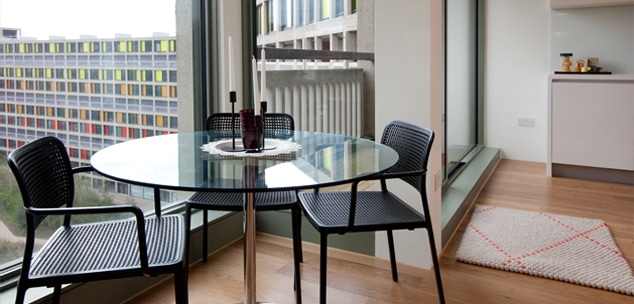Park Hill, the regeneration scheme in Sheffield, is a forward-thinking project that has transformed the largest Grade II Listed structure in Europe into modern flats and apartments. The multi-million pound makeover also includes shops, pubs and a community centre in an effort to emulate the sense of community that made the initial Park Hill estate a success in the 1960s.
 The original complex, which began planning in 1945 and was completed in 1961, became iconic thanks to its revolutionary ‘streets in the sky’ design, a famous example of the vision of architects Alison and Peter Smithson, the originators of the concept. From then on, Park Hill became a landmark building on the Sheffield Skyline, never to be overshadowed by its surrounding landscape.
The original complex, which began planning in 1945 and was completed in 1961, became iconic thanks to its revolutionary ‘streets in the sky’ design, a famous example of the vision of architects Alison and Peter Smithson, the originators of the concept. From then on, Park Hill became a landmark building on the Sheffield Skyline, never to be overshadowed by its surrounding landscape.
In its redevelopment, architects Hawkins Brown wanted to bring life and pride back into the area by creating and re-establishing a world class commercial and residential building that was superior inside and out.
Every design and build aspect therefore had to be carefully considered from the outset. Not only from an aesthetic and build quality point of view, but also sustainability in order ensure that a building was created that could truly represent the 21st century and beyond.
Finding wall and flooring solutions in keeping with the modern aesthetic of the building was necessary and important. Every material brought into the build had to support this whilst complementing the needs of modern-day living.
 For the spacious one and two-bedroom apartments, Fermacell’s gypsum fibre dry-lining board enabled the Park Hill complex to meet the required objectives, after being specified by Hawkins Brown Architects and main contractors, Urban Splash.
For the spacious one and two-bedroom apartments, Fermacell’s gypsum fibre dry-lining board enabled the Park Hill complex to meet the required objectives, after being specified by Hawkins Brown Architects and main contractors, Urban Splash.
Amongst its requirements, a board had to have the ability to support varying loads of weight without cracking, have noise-reducing benefits and be aesthetically pleasing yet sustainable.
Erik Purchase, the main contractor at Urban Splash, specified Fermacell for the project and said: “The fact that Fermacell board can support more weight safely than plasterboard and contributes greatly to noise reduction made it an ideal fit for the apartments of the new Park Hill development. Correctly installing the board did require a broader skill set from the fitter, but it is hugely beneficial as it removes the need for skimming which can introduce a lot of unwanted moisture into the indoor environment.
“The robust nature of the board, its load carrying capacity and its sound absorption were all key considerations in our decision to specify Fermacell for the project. There were a number of requirements that had to be met, so the board we specified needed to be flexible and superior in its performance benefits. We are shortly about to begin the design of phase two of the Park Hill project and Fermacell board will be very much in our thinking.”
Andrew Richardson, Fermacell’s technical manager, commented: “The board provides many benefits to modern living in a complex such as Park Hill. For example, its acoustic performance greatly aids sound reduction giving people a little peace and quiet in their homes. Additionally the 30kg single screw and up to 50kg cavity plug load bearing means that it can keep up with room layout changes and the moving of heavy items like televisions and mirrors from wall to wall, without the tell-tale signs of wear.
“Our dry-lining board combines the load-bearing performance properties of solid blockwork with the speed and flexibility of conventional drywall construction. This means that the turnaround time of a commercial project of the scale of Park Hill will be greatly enhanced because installers don’t have to think about secondary support. There will also be no reduction in room space.”
Andrew Richardson concluded: “The rapid finishing performance benefits of Fermacell’s dry-lining board, such as not needing to be plastered and its smooth, ready-for-painting finish really shine through during a project of this type, which is great to see. Fermacell is a multi-purpose board type that allows designers to use radical solutions in internal space planning across a wide range of projects and commercial sectors.”
The project is now entering phase two on the site and 40,000 square metres of Fermacell have been specified to date.


